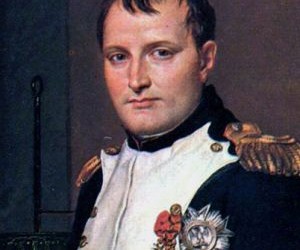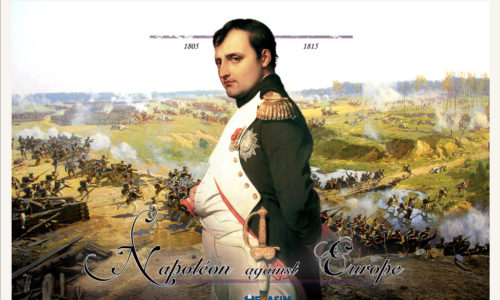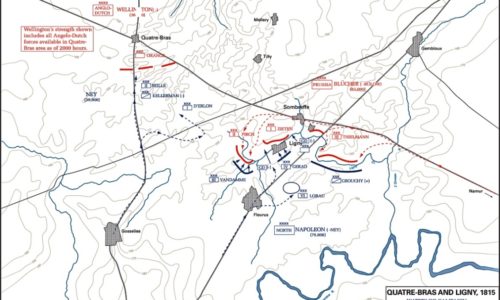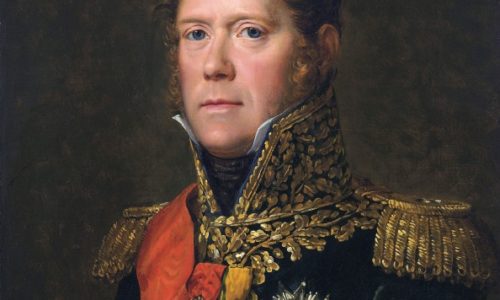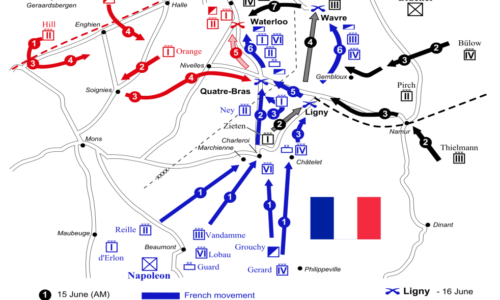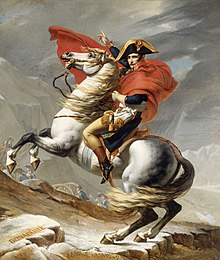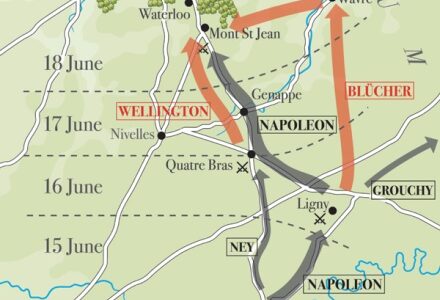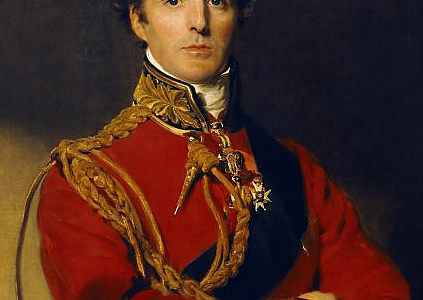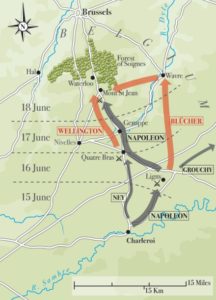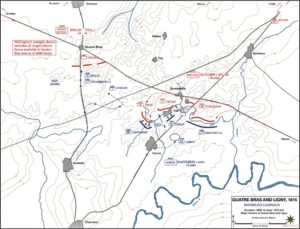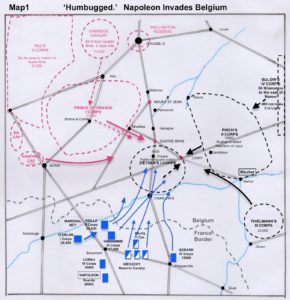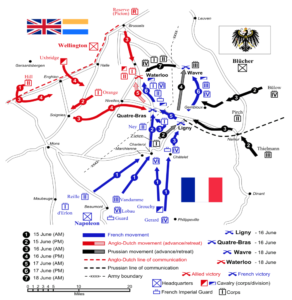Waterloo
By Paul Fish:
Napoleon was confident that he could defeat the Prussian army at Ligny on June 16, 1815, and then go on to defeat the combined Allied army under Wellington the next day. While the events at Quartre Bra and Ligny on the 16th, and the day of reorganization on the 17th, lead to the ultimate defeat at Waterloo on the 18th, where should the blame for this crushing loss be placed?
Is it Napoleon’s poor judgment and his lack of clear orders to his subordinates that caused the problem? Is it Ney’s lackluster performance on the first day that allowed Wellington to take a strong position? Was it Grouchy’s poor command skills and his failure to march to the sound of the guns that ultimately lead to the French forces being routed late in the day at Waterloo?
This article will explore these factors and try to come to a conclusion with respect to the biggest blunders. (The events of the battles of Ligny, Wavre, and Plancenoit can be experienced in the new game from Legion Wargames, “Black Eagles Over Belgium.”)
First, let’s look at each of the major commanders. Obviously, Napoleon was the Emperor and the overall commander of the French army. But for most of the 15 years prior to 1815, Marshal Berthier was Napoleon’s chief of staff where he translated his commander’s garbled, sometimes imprecise, requirements into clear and easy to understand orders. When Napoleon returned to France that spring, Berthier who was living in Bamberg in Saxony at the time, tried to rejoin him but was stopped at the border and returned to his castle in Bamberg, where he was murdered on the orders of the Comte d’Artois.
To make matters worse, Napoleon had never decentralized his command or set up a staff system as his generals were expected to follow his orders to the letter. Moreover, Napoleon did not trust Marshal Soult and worried about leaving him in the capital where he could cause trouble or change sides again. Therefore, he appointed Soult to be his new chief of staff. A job that he was not prepared for or even wanted, which resulted in much of the French armies orders being poorly written. In fact, many of Napoleon’s problems can be directly traced to the poor staff work of Soult.
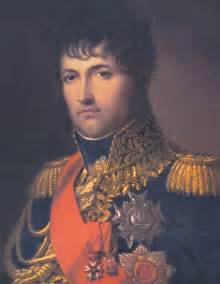 Marshal Soult
Marshal Soult
In addition, during the Waterloo campaign, Napoleon lacked his best fighting and independent thinking Marshals. Lannes had been killed in 1809, Davout was needed to defend the capital and Suchet and Brune were given other commands.
Napoleon apparently felt that he needed to show his generals that he could still reward or demote people who showed leadership or the lack thereof. For example, he made Grouchy a Marshal and took the baton away from Marmont, Augereau, and Victor. He gave corps leadership to Reille, Vandamme, and d’Erlon, hoping that they would become Marshals at a future date.
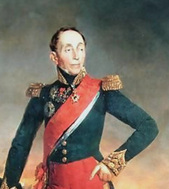 Marshal Grouchy
Marshal Grouchy
As Marshal Ney was a trusted battle-hardened leader, he was given command of the left wing of the Army du Nord (about 30,000 men). This was necessary as Napoleon needed to coordinate the two wings of his army he had separated on the evening of the 15th of June. Therefore, Ney was sent to take the key crossroad of Quatre Bra from the Dutch and English forces, while the Emperor accompanied the larger portion of his army to a position outside of Fleurus.
Around 4 a.m. on the 16th, Marshal Ney was trying to close up his ranks. French General D’Erlron was below Jumet with 2 divisions. General Allix was still crossing the Sambre by 5 a.m. General Reille, on Ney’s orders, had sent Bachelu’s division up to Farsnes in support of General Lefebvre-Desnouettes’ cavalry.
Napoleon sent orders to his two wing commanders between 8 and 9 a.m. He also sent a second copy of the orders to Ney with his Imperial ADC, General Count Flahaut. Flahaut was to verbally explain the orders to Ney, so there would be no misunderstandings. Flahaut wrote:
“..I was directed to give them to Marshal Ney by word of mouth. I, therefore, gave him as from the Emperor the order to move to Quatre Bra, to hold this important point in strength, and (should the enemy allow him to do so) to support with every man at his disposal the Emperor’s offensive against the Prussian army.”
However, Marshal Ney was never given exact orders as to which troops were to be sent to aid Napoleon in his fight with the Prussians, nor was he given a time as to when to move these troops. As things developed Napoleon expected some of Ney’s men to arrive on his extreme right during the afternoon. These fresh troops would then deliver the decisive blow to the Prussians, who would have no choice but to retreat.
At 2 p.m. Soult sent a message to Ney informing him of the then imminent battle at Ligny and giving Ney general orders.
“The Emperor desires me to inform you that the enemy has collected a Corps of troops between Sombreffe and Brye and at 2:30 p.m., Marshal Grouchy with the III and IV Corps will attack the enemy’s positions. His Majesty’s desire is that you will attack whatever force of the enemy is directly opposed to you, and after having driven it aside you will turn in our direction, so as to bring about the envelopment of that body of the enemy’s troops whom I have just mentioned to you (the Prussian Corps of troops). If the latter is overthrown first, then his Majesty will maneuver in your direction, so as to assist your operations in a similar way. Inform the Emperor forthwith of your dispositions, and all that goes to your front.”
Marshal Ney received Soult’s first message of the afternoon before British General Picton’s division entered the fight. Ney may have sent a message back to Napoleon that all was going according to plan. He was forming up General d’Erlon’s corps at Frasnes. It would be available for transfer to Napoleon, but Soult’s note did not indicate any sense of urgency or danger in Ney’s mind. Ney felt confident that Napoleon had more than enough men to defeat a single Prussian Corps. Ney was probably shocked to receive the second letter from Soult at around 3:15 p.m.
“I wrote to you an hour ago to inform you that at 2:30 p.m., the Emperor would attack the position taken up by the enemy between the villages of S. Amand and Brye. At this moment the action is in full swing. His Majesty desires me to tell you that you are to maneuver immediately in such a manner as to envelop the enemy’s right and fall upon his rear; the army in our front is lost if you act with energy. THE FATE OF FRANCE IS IN YOUR HANDS. Thus do not hesitate even for a moment to carry out the maneuver ordered by the Emperor, and direct your advance on the heights of Brye and S. Amand so as to co-operate in a victory that may be decisive. The enemy has been caught in the very act of carrying out his concentration with the English.”
Ney now held the key to victory
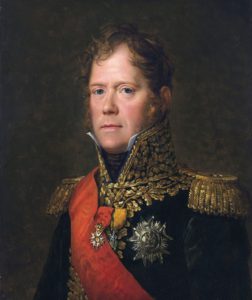 Marshal Ney
Marshal Ney
Evan so, Ney was not getting a true picture of the events unfolding around Ligny. He had no way of knowing that his lack of response to the orders sending a portion of his troops in support of Napoleon was to be critical in the outcome of the battles. Napoleon at the same time was thinking that Ney could handle things against Wellington without any help from the right wing. Napoleon, therefore, sent orders directly to General d’Erlon to move his Corps to S. Amand.
These orders were transmitted by the Imperial Aide de Camp, General le Comte de la Bedoyere. When Bedoyere reached Frasnes he found that d’Erlon was not present, so he gave the orders to d’Erlon’s Chief of Staff, General Delambre. Delambre rode forward and showed the letter to General de Salle, commander of the Corps Artillery of the French Army. So it fell to De Salle to direct the other divisional commanders to get their men moving. De Salle later recalled his confusion over the content of the order.
“Having no map of Belgium before me, it is possible that I am transposing the names of the two villages. I rather think that it was ‘at St. Amand’ and ‘fall on Ligny’, otherwise I made no mistake.”
As the afternoon proceeded, Ney was thinking that he could not afford to send d’Erlon corps to assist Napoleon. He consequently, countermanded the orders to d’Erlon and told him to return to the battle at Quatre Bra. This effectively took d’Erlon’s Corps out of both battles as they spent the day marching back and forth on the same road and never appeared on either battlefield.
Consequently, mistakes were made by all the parties involved in the events of June 16.
Napoleon never informed his wing commanders as to the big picture. He failed to tell Ney what he expected from him until it was too late to act. Marshal Soult wrote vague and ambiguous orders that failed to spell out what actions Napoleon wanted from Ney. Plus he transmitted inaccurate information as to the size of the force that Napoleon was facing. Ney overreacted to his situation, feeling that he was the more important of the two battles; he was reluctant to release the troops that Napoleon needed. In fact, Ney never grasped the overall plan for the 2-day engagement.
Events of June 17, 1815
Now for a look at the events of June 17th, 1815 and how they shaped the critical battle of the next day. At the end of the fighting, at Quatre Bra, Ney did not send a report to Napoleon. There was no dispatch informing the Emperor of the outcome of the battle or the positions of the force that were involved. Napoleon was still in the dark as to these things as dawn approached. Finally, General Flahaut, who has spent the previous day with Ney, reported in person to the Emperor.
“When night came each side held its ground. I had supper with Marshal Ney and went off afterward to join the Emperor. I reached Fleurus between 6 and 7 o’clock in the morning (of the 17th). Marshal Ney had no time to make a report and ordered me to explain to the Emperor what had occurred. My account was far from giving him satisfaction.”
Napoleon learned that Ney had not been informed of the results of the battle of Ligny. He, therefore, remained unsure of what was expected of him and awaited further orders. This alarmed Napoleon who had presumed that Ney had retaken the offensive and held the key crossroads of Quatre Bra. Thence Napoleon rethought his plan to march along the Namur road. He told Soult to write to Ney to inform him of the victory at Ligny and to press the left wing to immediately attack the Allied forces to his front.
At the same time, the French right wing under the command of M. Grouchy was supposed to be pursuing the Prussians as they retreated from the battlefield. Grouchy wrote in his memoirs (years later) that, in fact, he went to see Napoleon at 8 o’clock in the morning, but was told that he was still asleep. He waited almost 2 hours before he could report to the Emperor that Pajol’s forces had followed the Prussians along the road to Namur. This implied that Blucher and his large army were in retreat and retiring on Namur and Maastricht. Soult even informed the Minister of War that the Prussians were going to Namur and Wellington was retreating to Brussels. Grouchy further claims that it was after 1 o’clock when Napoleon finally gave the orders to pursue the Prussians.
“Up to half-past noon on the 17th of June the Emperor – who until then had ordered no movement of the army – was waiting a report from Marshal Ney; as soon as he received it, he ordered Marshal Grouchy to take his place at the head of the corps of infantry under Generals Vandamme and Gerard and of the cavalry under Generals Pajol and Exelmans, forming a body of some thirty thousand men, and to follow the Prussian army…”
Grouchy gave orders to his generals to march in the direction of Namur. However, he made the mistake of sending all his troops on the same road. He then compounded this blunder by telling the French general Vandamme to take the lead even though he was the furthest to the west. General Gerard had to wait until the whole of Vandamme’s corps reached him and then marched past before he could move his men out. If this wasn’t enough of a slowdown, at 2 pm it started to rain heavily, which only made the roads worse.
Shortly after 3:30 pm, Grouchy received a Message from General Pajol of the cavalry, saying his scouts had reported back that the Prussians they had been following were only a few stragglers and the main part of the Prussian army had gone in another direction.
As Grouchy’s aide de camp, Captain Bella brought a letter from French General Exelmans.
“17 June 1815
Monsieur,
I have the honour to inform you of the movement that I have made on Gembloux this morning, following the enemy who has massed there.
I have observed them until now and I have not seen them move. The army is on the left of the Orneau; on the right of this river it has only a single battalion in front of Basse-Bodece. Immediately that it moves off, I will follow it.
Lt. General Exelmans”
Exelmans had found Thielemann’s III Corps of the Prussian army that had retreated in good order and had rested by Gembloux. Grouchy next received orders from Napoleon, telling him to move his forces to Gembloux. For the second time that day Grouchy ordered his troops to change direction and proceed to Gembloux. And again he reverses the marching order of the units with Vandamme’s corps changing position with Gerard’s corps. As the roads were muddy, it took IV Corps 7 hours to move to Gembloux, which caused them to arrive at 11 pm
To summarize the events of June 17th, Ney was remiss in not sending a detailed report to Napoleon at the end of the day on the 16th. Nor did he tell his commander the outcome of the battle or the disposition of the forces. This mistake caused Napoleon to delay sending out orders for the day on the morning of the 17th, until around noon. Plus Napoleon was misinformed as to the retreat route of the Prussians. Additionally, Grouchy did not order his cavalry to pursue the Prussians until he received orders to do so from Napoleon. Of course, if Grouchy had been a more experienced commander he might have told General Pajol to be more aggressive in his pursuit early in the day. Grouchy further complicated his mistakes by not having a feel for the road network and the relative positions of his forces.
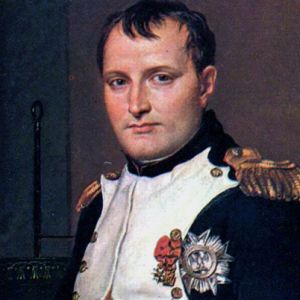 Napoleon Bonaparte
Napoleon Bonaparte
The frustrations of many senior officers can be felt by the remarks of General Berthezene in his memoirs:
“Leaving the battlefield of Ligny towards midday on the 17th, Grouchy’s small army went to Gembloux and bivouacked there. The weather had been very poor; the rain fell in torrents and degraded the tracks, which held up our march and made it more tiresome. No one knew which way the enemy had gone for, on the evening of the 16th, their traces had been lost. The equipages, which he had sent to Namur, had contributed considerably to throw uncertainty into the spirit of Marshal Grouchy.”
Captain Gerbert adds:
“Those (Prussians) who had left Ligny after the battle the day before at 10 pm therefore had more than a fourteen hour lead on us. There was reason to think that these fourteen hours would be well employed by the enemy. He rejoined Bulow’s corps without a problem, who was 20,000 men strong (actually 30,000), and who had not been able to arrive to take part in the battle of Ligny. With these reinforcements, Blucher’s army found itself more formidable than the day before when he offered battle, from then the vanquished could defy the victor.
During the night of the 17th, the Prussians moved their main force to the area around the town of Wavre. The Prussian General Thielemann was blocked by the French units on the road from Namur to Quatre Bra. He, therefore, placed his men just north of the town of Gembloux. This is where Exelman’s dragoons found him earlier in the day. He then moves further north to join with Bulow’s corps outside of Wavre.
Early in the morning of the 18th, (3 am) Grouchy sent a confusing note to the Emperor. He talked about where the I and II Prussian Corps are moving to, Corbais and Chaumont, but never mentions the concentration of forces at Wavre. He admitted that there are no Prussians on the way to Namur as he had stated the night before. Grouchy does tell Napoleon that he will be moving toward Wavre with his forces. Grouchy and Pajol also exchange notes between 3 am and 5 am with Pajol reporting that Namur was vacant, but that he has been told there were between 25 to 30,000 Prussians massed near Gembloux. Grouchy then replies that the Prussians are retreating toward Brussels, but this information was never given to Napoleon. Grouchy further orders Exelmans and Vandamme to move to Wavre. He sends another order to Commandant Pont-Bellanger, to find out if Prussians have been seen at the bridge at Moustier over the Dyle River. Pont-Bellanger responds:
“Before daybreak on the 18th, when leaving Gembloux, the marshal sent an officer, his aide de camp Pontbellanger, with several men of his escort, to make a reconnaissance to the left and particularly toward the bridge of Moustier, in order to assure himself if the Prussians had crossed there. His report was that the enemy was heading towards Wavre, that none of their troops occupied the bridge nor the banks of the Dyle.”
At the same time that Grouchy was moving his forces toward the Prussians at Wavre, Bulow’s IV Corps was starting its march toward Waterloo. They were followed by II Corps, then I Corps and finally by III Corps. As Wavre was one hour’s march closer to Waterloo than Gembloux, it became impossible for Grouchy and his men to intercept or cut off the Prussian advances to the Waterloo battlefield. Although Grouchy had all of his units moving in the direction of Wavre by 10 am. he again gave orders that used only 1 road, thus causing additional traffic jams. At 11 am Grouchy sends a lengthy letter to Napoleon detailing all that he knows of the Prussian positions and their movements. He thinks that the Prussians are planning to join forces with Wellington just outside of Brussels. Even at this late date he seemed unable to grasp the overall tactical situation and there was now no way for him to prevent the junction of the Allied forces from the location that he occupied.
The fighting at Waterloo begins shortly after noon.
At the same time, General Gerard was having lunch with Marshal Grouchy when they heard the sounds of distant cannons. Gerard then tells Grouchy that should march at once toward the sound of the guns.
“Monsieur le marechal, it is an axiom of war that one should march to the cannon when one hears the cannon.”
However, Grouchy strongly disagrees. He states that their orders are to attack the Prussian force in and around Wavre. This will keep the French from moving in the direction of the fighting at Waterloo and allowed the bulk of the Prussian Army to move from Wavre to Waterloo late in the afternoon, just in time to turn the tide of the battle for the Allies.
In summary, there were mistakes made by almost everyone on the French side during the 3 days of the Waterloo campaign. Napoleon was lax in his handling of his subordinates. Ney was not clear as to his mission at Quatre Bra. Grouchy was given too much latitude in the handling of his forces. Napoleon also waiting until 11 am to begin the battle may have cost him valuable daylight and Soult should have never been given the job of Aide de Camp for Napoleon, as he wrote ambiguous orders and was slow in transmitting them.
But Grouchy was the worst of the group. He was poor at handling his forces and repeatedly sent his force along a single road when there were many parallel roads available. He was not aggressive enough in his pursuit of the Prussians after the first day of fighting. He also lost track of their locations and spent much of the next day trying to find them again. And once he was engaged with the Prussian forces he refused to march in the direction of the main battle at Waterloo to help his Emperor.
This lack of understanding of the overall picture of the forces engaged was the single biggest cause of Napoleon’s defeat at Waterloo. If Marshal Grouchy had been able to block the movement of the Prussians toward the battle, Napoleon would not have had to send the Guard to defend Plancenoit on his flank, and even without Grouchy’s men, he might still have defeated Wellington and changed the history of Europe.
Bibliography:
Corrigan, Gordon “Waterloo: Wellington, Napoleon and the Battle That Saved Europe” Pegasus Books Ltd. New York, 2014.
Field, Andrew W. “Grouchy’s Waterloo” Pen and Sword Books, Ltd, South Yorkshire, 2017.
Hamilton-Williams, David “Waterloo New Perspectives, The Great battle Reappraised” John Wiley & Sons, Inc. New York, 1994.
Nofi, Albert A. “The Waterloo Campaign” Combined Books Inc. Conshohocken, Pa 1993.


